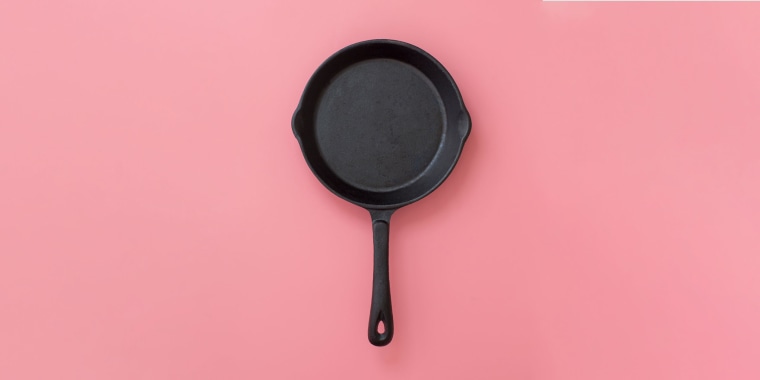Cast-iron skillets are a go-to piece of cookware for professional chefs and home cooks alike. They are a jack of all trades — you can use them to sear thick cuts of meat, pan-fry hearty vegetables and even handle more delicate things like scrambled eggs and pancakes. Skeptics will claim that cast-iron skillets are difficult to maintain and require too much effort. In reality, a well-cared-for cast-iron pan only needs a little love, and it will reward that effort by lasting a lifetime. Knowing how to season a cast-iron skillet is the first step toward proper cast-iron care. Ahead, we’ll explain how to do it and why it’s such an important step.
So what exactly does seasoning cast-iron cookware entail? It has nothing to do with salt and pepper. Seasoning cast-iron serves two purposes, says Will Copenhaver, vice president of marketing and sales at Smithey Ironware Company. Cast-iron is porous, so seasoning helps to fill the holes left from the casting process and create a more even cooking surface. Seasoning also helps create a naturally nonstick surface without the use of any chemical coatings that you might find on manufactured nonstick pans. Copenhaver compares seasoning a skillet to adding a layer of primer on your walls before painting. “It helps protect the cast-iron from exposure to air and moisture,” he says. Too much exposure to the elements can cause the surface to rust, deteriorate and lose its natural nonstick abilities.
How to season a cast iron skillet
There is more than one way to season a cast-iron skillet, and a lot of modern cookware comes pre-seasoned these days. Copenhaver explains that seasoning occurs when the fat molecules in cooking oil bond with the iron in the pan when it’s exposed to heat. “The source of the heat is really up to you. You can achieve a strong seasoning on a stovetop or in the oven,” he says.
The most common seasoning technique is the oven method. To season a cast-iron skillet in the oven, wipe the interior and exterior of the pan with a thin layer of oil and bake it at a high temperature (somewhere between 450 and 500 F) for about one hour. Let the pan cool before using. This method takes some time (although it’s mostly hands-off) but it is a tidy way to add a layer of seasoning to the skillet without smoking up the kitchen.
To season a cast-iron skillet on the stovetop, add a thin layer of oil to a clean, dry skillet and crank up the heat to high (turn on the kitchen fan if possible). Once the oil begins to smoke, turn off the heat. Coat a layer of paper towels with more oil and grip it with a pair of tongs. Carefully run the greased paper towels over the interior surface of the skillet — you’ll see the color darken in a matter of minutes. This method is super quick and effective.
Whichever method you choose, it’s always a good idea to use a neutral cooking oil with a high smoke point, such as canola, avocado, peanut or sunflower oil. Because of the extreme heat, whether it’s contained in the oven or out in the open on the stovetop, there will be some smoke. Olive oil is great for cooking, but it has a much lower smoke point than many other types of oil, so it’s not recommended for seasoning cast-iron.
Even if you’re working with a pan that comes pre-seasoned, it can still take some time to develop a mature layer of seasoning. When using a new cast-iron skillet, Copenhaver recommends cooking dishes with a little extra fat. This allows the food to move more freely around the pan, getting into all of the nooks and crannies of the cast-iron surface.
In the end, it’s less about how many times a year you season the skillet and more about how often you use it. Every time you cook in your skillet, you are developing a deeper seasoning without even realizing it. If you’re actively using your cast-iron skillet in your day-to-day cooking, there’s no need to continuously “season” it separately.
What to cook with a cast iron skillet
A few questions inevitably arise surrounding cast-iron care. First: is it okay to cook acidic foods like tomatoes or citrus? The short answer is yes! Contrary to popular belief, cast-iron can handle acidic foods — that is if the pan is properly seasoned first. Acidic foods like tomatoes are more likely to seep into the pores on the surface of the pan, so if it’s unseasoned, the ingredients might stick to the pan or cause it to rust.
How to clean a cast iron skillet
Second: is it okay to get the skillet wet? This is probably the biggest myth about cast-iron cookware, and we hear it all the time. Exposure to moisture does cause the pan to develop rust, but that’s only if it’s exposed for a long period of time. You shouldn’t soak cast-iron in the sink overnight, but it’s perfectly fine to scrub the pan with warm soapy water after cooking — just be sure to dry it off right away.
Copenhaver also recommends applying a light layer of neutral cooking oil after cleaning and drying the skillet. This helps to keep the interiors looking fresh and shiny.
